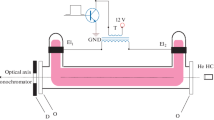Abstract
Absorption of probe laser radiation by a mixture of even isotopes of neon in a gas discharge plasma is investigated by the method of magnetic scanning of 3s2–2p4 transition. The contours of absorption lines of isotopes are resolved by means of numerical modeling. It is discovered that, upon decrease in relative concentration of one of the isotopes, its contribution to absorption is replaced by gain. The effect is found to be caused by radiative transfer of excitation energy between atoms of different kinds in the absence of a difference in level energies (the process known as optical pumping). The effect of this mechanism turned out to be substantial for the upper level transitions from which to the ground state are allowed while being absent for the lower level of the transition from which such transitions are forbidden although other decay channels are available.






Similar content being viewed by others
Notes
This could not be done due to the lack of a physical model of the phenomenon.
Admixture of neon-20 isotope in neon-22 could be as high as 10%.
Study [15] put an end to the appearance of contradictory publications interpreting broadening of this line of neon as being due to the van der Waals interaction by corroborating the Kazantsev theory [16] according to which broadening of the 6328-Å line of neon in atomic collisions is determined by overlap of electron shells of the atoms.
The numerical processing of amplitudes of these contours yielded the values of +3.46 and –2.05%.
Magnetooptical spectra corresponding to transition 3s2–2p4 provide information on level populations formed by the processes of optical pumping that are largely unrelated to emission of this transition itself. Therefore, it would be beneficial if its isotope splitting were larger than the linewidth, and magnetooptical spectra of the isotopes did not overlap. On the contrary, it would be disadvantageous if the isotopic shift were small. In the latter case, resolving the spectra of the isotopes and comparing associated with them absorption becomes more difficult.
REFERENCES
M. P. Chaika, Interference of Degenerate States (Leningr. Gos. Univ., Leningrad, 1975) [in Russian].
E. B. Aleksandrov, G. I. Khvostenko, and M. P. Chaika, Atomic State Interference (Nauka, Moscow, 1991) [in Russian].
E. G. Saprykin, S. N. Seleznev, and V. A. Sorokin, JETP Lett. 76, 264 (2002).
S. G. Rautian and E. G. Saprykin, Opt. Spectrosc. 92, 342 (2002).
I. Tkhek-De, E. G. Saprykin, and A. M. Shalagin, Opt. Spektrosk. 35, 202 (1973).
S. G. Rautian, JETP Lett. 60, 481 (1994).
S. G. Rautian, J. Exp. Theor. Phys. 81, 651 (1995).
I. V. Barybin, V. A. Sorokin, and A. E. Churin, Opt. Spectrosc. 95, 869 (2003).
E. G. Saprykin, S. N. Seleznev, and V. A. Sorokin, J. Exp. Theor. Phys. 97, 1102 (2003).
E. G. Saprykin, Opt. Spectrosc. 123, 309 (2017).
E. G. Saprykin, J. Exp. Theor. Phys. 122, 216 (2016).
E. G. Saprykin, Opt. Spectrosc. 122, 549 (2017).
E. G. Saprykin and V. A. Sorokin, Opt. Spectrosc. 109, 521 (2010).
V. N. Lisitsyn and V. P. Chebotaev, Sov. Phys. JETP 27, 227 (1968).
I. Tkhek-De, A. P. Kazantsev, S. G. Rautian, E. G. Saprykin, and A. M. Shalagin, Quantum Electron. 4, 234 (1974).
A. P. Kazantsev, Opt. Spektrosk. 37, 1028 (1974).
K. S. E. Eikema, W. Ubachs, and W. Hogervorst, Phys. Rev. A 49, 803 (1994).
O. P. Bochkova and S. E. Frish, in Spectroscopy of Gas Discharge Plasma (Nauka, Leningrad, 1970), p. 319 [in Russian].
Laser Reference Book, Ed. by T. Prokhorov (Sovetskoe Radio, Moscow, 1978), Vol. 1 [in Russian].
E. B. Aleksandrov and N. N. Yakobson, JETP Lett. 26, 333 (1977).
B. E. Aleksandrov and N. N. Yakobson, Opt. Spectrosc. 48, 457 (1980).
L. A. Vainshtein, V. R. Mironenko, S. G. Rautian, and E. G. Saprykin, Opt. Spectrosc. 87, 341 (1999).
E. G. Saprykin, Opt. Spectrosc. 120, 212 (2016).
ACKNOWLEDGMENTS
I am grateful to V.A. Sorokin for his contribution to creation of the automated experimental setup and V.A. Tomilin for his help in conducting the measurements.
Funding
This research was carried out within the framework of the Program of Priority Research of the Siberian Branch of the Russian Academy of Sciences (Program II.10.2) and grant NSh-6896.2016.2 of the President of the Russian Federation for Support of Leading Scientific Schools.
Author information
Authors and Affiliations
Corresponding author
Ethics declarations
The author declares that he has no conflict of interest.
Additional information
Translated by I. Shumai
Rights and permissions
About this article
Cite this article
Saprykin, E.G. Inversion of the Contribution of an Isotope of Small Relative Concentration to Total Absorption Coefficient of a Mixture of Neon Isotopes Associated with the 3s2–2p4 Transition. Opt. Spectrosc. 127, 177–189 (2019). https://doi.org/10.1134/S0030400X1908023X
Received:
Revised:
Accepted:
Published:
Issue Date:
DOI: https://doi.org/10.1134/S0030400X1908023X



